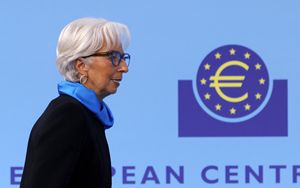(Finance) – Government bond yields are moving upwards, in view of the central banks’ next moves regarding monetary policy. The first decisions of the new year are made by ECB which will meet on Thursday 25 January. The following week it will be the turn of the Federal Reserve. Today, the Bank of Japan kept rates stable at -0.10%, leaving the mechanism for controlling the yield curve of the JGB, the Japanese ten-year bond, unchanged.
The spread between BTP and Bund stands at 160 points, with the Italian ten-year rate increasing by six basis points to 3.91%. It also goes up German Bund which stands at 2.31% (+3 points). On the rise Spanish tenth anniversary at 3.21% (+5 points) and that Greek at 3.35% (+6 points).
An ECB firmly waiting
“We expect the European Central Bank to keep key rates unchanged at its January meeting and reiterate its data-dependent approach – he explains Konstantin Veit, Portfolio Manager at PIMCO – adding that the March meeting, with the new macroeconomic projections of the ECB staff, will probably provide further indications”. Short-term growth – underlines the expert – should be weaker than expected. However, the inflation forecasts of December were based on the interest rate path indicated by market data as of November 23, 2023. This data suggested a rate reduction of approximately 75 basis points for 2024. Financial conditions have eased significantly since then and updated projections will be made notes at the March meeting. Market forecasts currently suggest around 140 basis points of rate cuts for this year, starting in Apriland a terminal rate close to 2% in 2025. Due to uncertainty over the inflation outlook, “we doubt that the ECB will implement rate cuts so soon,” explains Konstantin Veit. “The ECB is likely to continue to monitor inflation closely without prematurely declaring one’s success.”
“Despite clear signs of weakening of the euro area and the return of inflation towards target, we expect the ECB to keep rates unchanged at its next meeting is that the prospect of cuts is still distant – he claims Katharine Neiss, chief European economist of PGIM Fixed Income -. Our reasoning follows from comments from the ECB, which suggest that the Governing Council would like to see an easing of a number of factors influencing underlying domestic inflationary pressure. This – he adds – includes not only core and services inflation, but also i wages hey corporate profit margins. So the second quarter would be the earliest period for cuts. Simply put, monetary policy makers will want to tread carefully and be sure that the inflation genie has been put firmly back in the bottle. As well as being “data dependent”, the ECB said interest rate rises in the latter part of 2023 represent insurance against the possibility of further food and energy price shocks and against the prospect of a decoupling of inflation expectations. Although food and energy prices have recently fallen and energy reserves in Europe remain high – underlines Katharine Neiss – the escalation of tensions in the Middle East suggests that it may be too early to abandon this insurance. Our basic hypothesis is therefore that the ECB will cut rates in the summer, leaving rates closer to 3% by the end of the year. That said, the rapid deterioration in activity at the end of last year has increased the risk that the ECB may have adopted an excessively restrictive policy in 2023. Short-term inflation has seen a clear downward trend for both core and services inflation, and is now at or below the level consistent with the 2% target. In such an environment, later rather than timely action would exacerbate downward pressure on inflation, risking a return to the pre-pandemic period of chronic below-target inflation in the area. In this case, “we could see the ECB remove insurance sooner rather than later, and cut rates more aggressively than in our baseline scenario,” she concludes.
